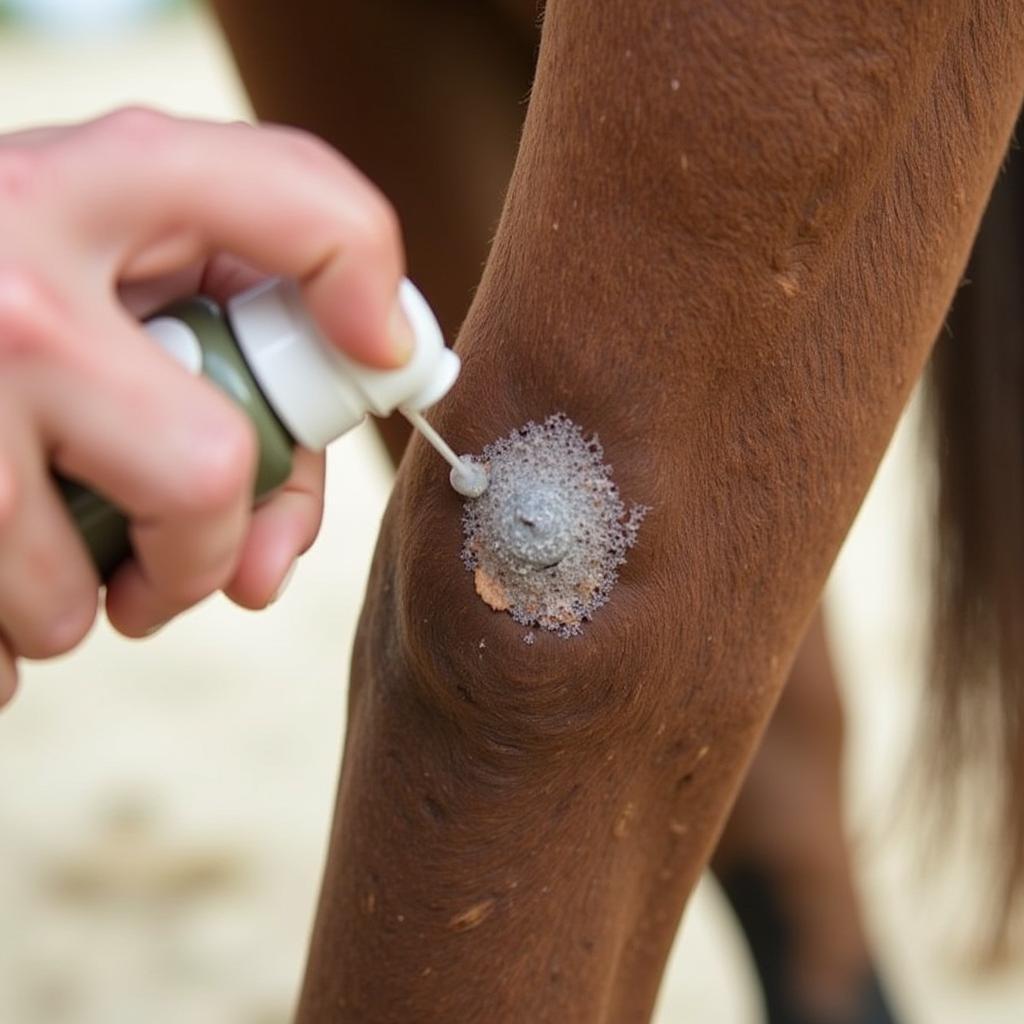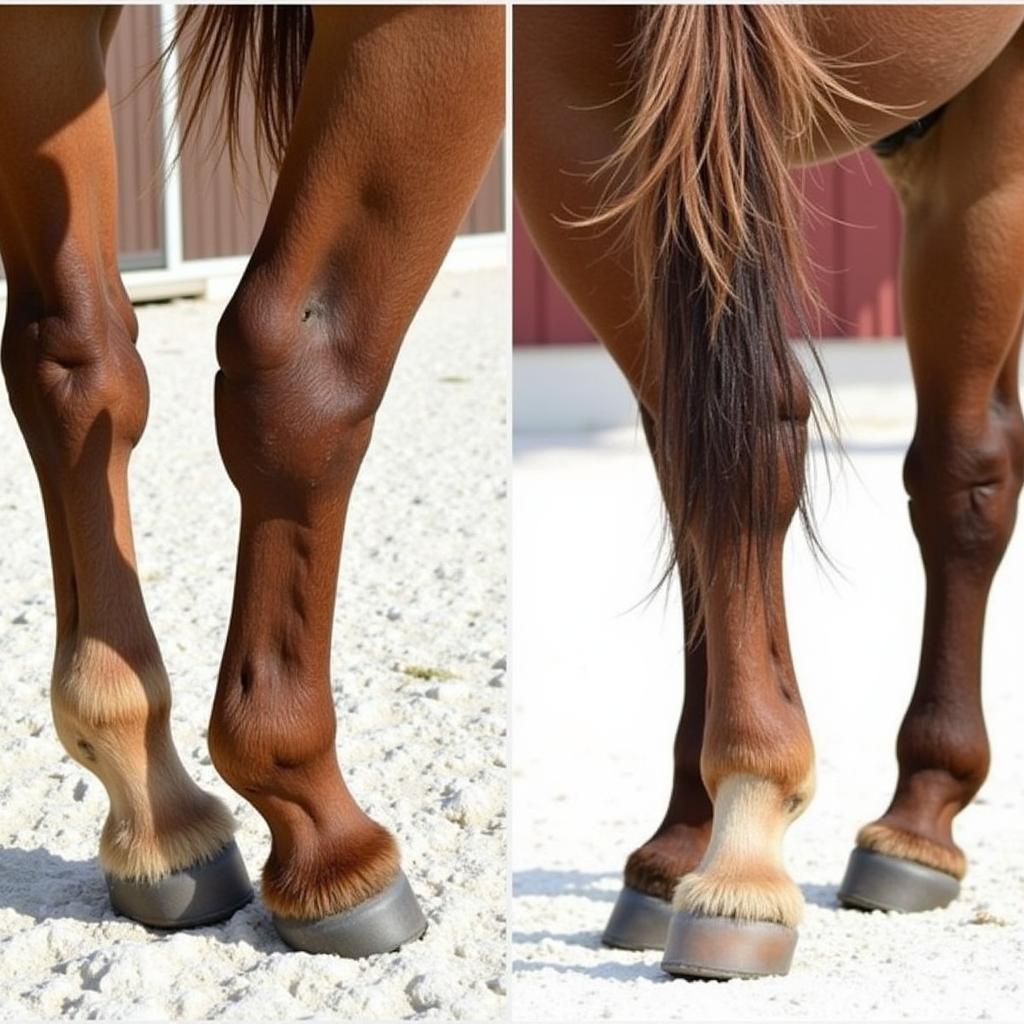Wound Kote For Horses is a popular choice for treating minor wounds and abrasions. Understanding how to effectively and safely use this product is crucial for any horse owner. This guide will delve into the specifics of Wound Kote, exploring its benefits, proper application, and potential considerations.
Understanding Wound Kote
Wound Kote is a topical spray-on wound dressing designed for use on animals, including horses. It forms a breathable, waterproof barrier over the wound, protecting it from dirt, debris, and bacteria. This barrier also helps to maintain a moist wound environment, which promotes faster healing. The active ingredient in Wound Kote is typically aluminum, which acts as an astringent and antiseptic.
Benefits of Using Wound Kote for Horses
Wound Kote offers several advantages for horse wound care:
- Protection: It creates a barrier that shields the wound from external contaminants.
- Promotes Healing: The moist environment fostered by Wound Kote supports faster healing.
- Easy Application: The spray-on formula makes application quick and convenient.
- Versatile: Suitable for a range of minor wounds and abrasions.
 Applying Wound Kote to a Horse's Leg Wound
Applying Wound Kote to a Horse's Leg Wound
Applying Wound Kote: A Step-by-Step Guide
Proper application is key to maximizing the effectiveness of Wound Kote. Follow these steps:
- Clean the wound: Gently cleanse the wound with a mild antiseptic solution and remove any dirt or debris.
- Dry the area: Pat the wound dry with a clean, soft cloth or gauze.
- Shake the can: Shake the Wound Kote can vigorously before use.
- Apply the spray: Hold the can approximately 6-8 inches away from the wound and spray in a sweeping motion to ensure even coverage.
- Allow to dry: Let the Wound Kote dry completely before allowing the horse to return to its usual activities.
When to Consult a Veterinarian
While Wound Kote is effective for minor wounds, it’s essential to know when professional veterinary care is necessary. Consult your vet if:
- The wound is deep or involves significant tissue damage.
- The wound shows signs of infection (e.g., pus, swelling, excessive heat).
- The wound does not show signs of improvement after a few days of using Wound Kote.
- The horse exhibits signs of discomfort or distress.
Wound Kote for Horses: Frequently Asked Questions
Here are some frequently asked questions about using Wound Kote on horses:
How often should I apply Wound Kote?
Typically, once or twice daily application is sufficient. However, always follow your veterinarian’s instructions.
Can I use Wound Kote on puncture wounds?
No, Wound Kote is generally not recommended for deep puncture wounds. Consult your veterinarian for appropriate treatment.
Can I use Wound Kote on proud flesh?
While Wound Kote can sometimes help protect proud flesh, it’s best to consult your veterinarian for the most effective treatment strategy.
How long does it take for a wound treated with Wound Kote to heal?
Healing time varies depending on the severity of the wound. Minor wounds may heal within a few days to a week.
 Horse with Healed Wound After Wound Kote Treatment
Horse with Healed Wound After Wound Kote Treatment
Conclusion
Wound Kote for horses is a valuable tool for treating minor wounds and abrasions. Its ease of application and protective barrier make it a convenient option for horse owners. However, it’s crucial to use Wound Kote correctly and understand its limitations. Always consult your veterinarian for advice on treating more serious wounds or if you have any concerns about your horse’s health.
FAQ
- What is Wound Kote?
- How does Wound Kote work?
- Can Wound Kote be used on all types of horse wounds?
- What are the potential side effects of using Wound Kote?
- Where can I purchase Wound Kote for my horse?
- How should I store Wound Kote?
- What should I do if my horse ingests Wound Kote?
Situations where Wound Kote is commonly used:
- Minor cuts and scrapes
- Abrasions from tack or equipment
- Superficial wounds from fence or pasture injuries
Further Reading & Related Articles:
- Equine Wound Management Best Practices
- Understanding Common Horse Injuries
- First Aid Kit Essentials for Horse Owners
Need assistance? Contact us 24/7: Phone: 0772127271, Email: [email protected] or visit us at QGM2+WX2, Vị Trung, Vị Thuỷ, Hậu Giang, Việt Nam.